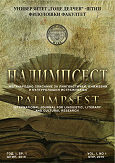INVESTIGATING THE HIGH FREQUENCY AND MORPHOLOGICAL PRODUCTIVITY OF VERB AND ADJECTIVE COMPOUNDS IN LEGAL ENGLISH CORPUS
DOI:
https://doi.org/10.46763/PALIM24917047hAbstract
This paper explores the complex relationship between morphological productivity and the high frequency of words in English. It delves into the theoretical underpinnings of these concepts, their empirical manifestations, and their significance in linguistics and cognitive science. By examining key studies and theories in the field, this paper aims to shed light on the complex interplay between morphological productivity and word frequency, offering insights into language acquisition, processing, and evolution. The paper also analyses the high frequency and the morphological productivity of adjective and verb compounds in EFL written contexts (Legal English context). The instruments used in this paper were research papers written by SEEU EFL students. A quantitative analysis of the high frequency and morphological productivity of compounds was performed using this dataset. Also, the correlation between morphological productivity and high frequency is being elaborated. The high-frequency list of compounds was calculated based on the compounds that appeared more than once in the analysed corpus. Whereas hapax legomenon was the quantitative indicator used to assess the output of the compounding patterns. The participants involved in this study were 35 undergraduate Law students at South East European University in Tetovo and Skopje, Republic of North Macedonia. The participants were attending the following courses: Level 5, Legal English 1 and Legal English 2. Findings imply that adjective compounds are more morphologically productive compared to verb compounds. Correspondingly, verb compounds are less morphologically productive however they are identified as highly frequent compounds compared to adjective compounds in the analysed corpus.
Keywords: high frequency; morphological productivity; adjective compounds; verb compounds; Legal English; corpus.


